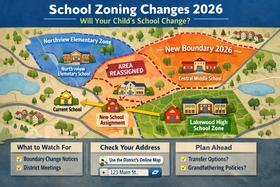In the United States, the typical kindergartener is five years old. If a child turns five in March or April of a given year, it is highly likely that he or she will start kindergarten the following September. However, for parents whose children’s birthdays fall in the latter half of the calendar year, the question of when to enroll a child in kindergarten becomes more complicated. The practice of “redshirting,” or delaying a child’s enrollment in kindergarten so that the child is slightly older than some of his or her peers, is common
As an article in the New York Times Magazine explained, American children are eligible to start kindergarten based on a birthday cutoff date that is determined by the state, or in some cases, by the local school district. Birthday cutoff dates vary greatly; the Times reports that in Indiana, a child must turn five by July 1 of the year he or she starts kindergarten, while in Connecticut, a child must turn five by January 1 of the year he or she is enrolled in kindergarten.
Although children are generally not allowed to enroll in kindergarten earlier than the cutoff date dictates, they are allowed to wait and enroll a year later if their parents so choose.
The practice of holding a child back so that he or she is slightly older than some of the other students in a classroom is known as “redshirting.” The popular Newsweek blog Nurtureshock reports that the proportion of students who are redshirted has doubled since 1980, going from 10 to 20 percent. For parents with children approaching kindergarten age, the question of whether or not to redshirt looms large.
This video examines the question of the best time to start kindergarten.
The Support for Redshirting
Relatively Older Students Outperform Their Younger Peers
A study published in 2006 by UC Santa Barbara’s Kathy Bedard and Elizabeth Dhuey seems to provide support for the belief that redshirting can give a child an academic edge. As Elizabeth Weil explained in the New York Times magazine, the study found that relatively older students performed four to twelve percentiles better than their younger peers in the fourth grade and two to nine percentiles better in the eighth grade.
The study’s authors also found that the relatively oldest students were 11.6 percent more likely to enroll in four-year colleges or universities. These findings seem to indicate that redshirting can provide a child with a competitive edge that lasts well beyond the first few years of school.
This video
Redshirting Gives Students Time to Prepare for an Academically Rigorous Kindergarten
Parents also advocate for redshirting because of the changing nature of kindergarten. As American public schools have begun moving towards greater accountability and more high-stakes testing, many states and districts have grown their expectations of kindergarten students. In her Times magazine piece, Weil claimed that the current kindergarten curriculum is “largely the same curriculum taught to first graders less than a generation ago,” and that “nationwide, teachers now report that 48 percent of incoming kindergartners have difficulty handling the demands of school.” Allowing a child to have an additional year of cognitive development may be very helpful in preparing him or her for the increasingly rigorous demands of K-12 education.
The Argument Against Redshirting
The studies that show the academic advantages provided by redshirting may seem to imply that the choice is simple: if you want to give your child the best chance of success, let him wait a year before enrolling in kindergarten. However, recent studies indicate that redshirting may not provide as straightforward an advantage as was once thought.
Older Students Have an Edge Because They Are Better Prepared, Not Because Of Their Age
Nurtureshock recently reported that a new study challenges assumptions about why older students perform better than their younger peers. The advantage that relatively older students enjoy is not a function of their age, but of the quality of the academic preparation that they receive in preschool, daycare, and at home.
The authors of the study use the findings as an argument against redshirting. The study indicates that children learn more and are better prepared for academic success when they are provided with intellectually stimulating environments at young ages. The ideal kindergarten classroom, note the study authors, provides just the kind of intellectual stimulation that a young brain needs.
This video offers another take on red-shirting.
Redshirting Equals “Sitting on the Sidelines of Learning”
The Nurtureshock bloggers also argue against redshirting, asking “is a 2-point statistical advantage worth having a child sit on the sidelines of learning for a whole year?”
Indeed, for low-income parents who cannot afford to provide their children with intellectually stimulating daycare or home environments, redshirting may do more harm than good. As San Francisco mother Amy Graff notes on a blog called The Mommy Files, “It's better for the kids to be in kindergarten than at home parked in front of a TV.”
The Bottom Line: An Individual Decision
The choice regarding when to enroll a child in kindergarten must ultimately be a personal one. Parents will want to consider the results of recent studies, but they should also consult with a child’s preschool teachers and pediatricians in order to understand whether redshirting is appropriate for their particular child.
For some children, an extra year in which to develop the cognitive skills needed for success in today’s kindergarten may be immensely helpful. For others, the intellectual stimulation that a vibrant kindergarten classroom provides may be more helpful in the long-term than any slight advantage that being older could provide. Unlike the items of the standardized tests that kindergarteners prepare to take, there is no one right answer to this question.
Questions? Contact us on Facebook. @publicschoolreview














